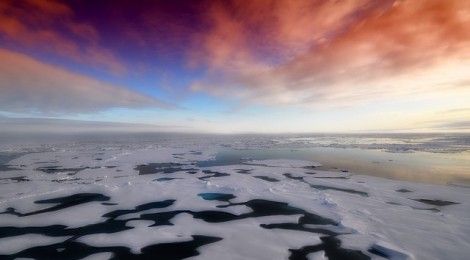
Everyone knows everything interesting there is to know about the Arctic, right? It’s that white bit at the top of our globes, Santa Claus lives there with Canadians, and it has Polar Bears. What else of interest could there possibly in such a remote location?
As it turns out, there are a few interesting facts that don’t make it out to the public. Here are just ten of those facts to get you started.
1. Nobody is quite sure about what countries own the Arctic.
For centuries now all the countries that touch the Arctic in some way (Canada, the U.S., Norway, Denmark, and Russia) have tried to expand their claims. Some of this has to do with the ability to exploit resources, some of it has to do with defense, and some of it has to do with just wanting to look bigger on world maps.
2. There are actually 4 North Poles.
There’s the map-related North Pole, denoting one end of the axis that the world spins around.
There’s the North Pole Dip, which refers to the point where the Earth’s magnetic field dips down to meet the surface of the planet (this is what compasses point to).
There’s the actual geomagnetic North Pole (not the same thing as the Dip) which is a sort of ring from which our protective geomagnetic barrier springs, protecting us from the sun’s radiation. It’s also part of the mechanism that gives us the Northern Lights.
And finally there’s a town in Alaska that was cheeky enough to claim the name North Pole even though it’s still quite a distance south from any of the other three naturally occurring North Poles.
3. The Arctic holds about 10% of the world’s fresh water.
That’s why scientists keep warning us about flooding if the polar ice caps melt. Another cause for concern is that the Arctic and Antarctic, being covered in ice shields, deflect a lot of sunlight back out into space, helping regulate the Earth’s temperature. The more the ice melts, the less of a protective shield we have, the warmer the Earth gets, until we have one great big problem.
4. There’s a Russian flag at the bottom of the Arctic Ocean.
Right under the terrestrial North Pole, to be exact. It was planted there by Russian scientist Artur Chilingarov in 2007. He went under the waves in the same submersible that was used to explore the watery grave of the Titanic.
5. Nobody is 100% sure about who reached the North Pole first.
The 1800s and the early 1900s were heady years for explorers looking for fame. They became household names as common folk followed their exploits in the newspapers, cheering for their homeland’s champion.
The race to be the first to reach the terrestrial North Pole was one of the big ones, contended by a number of countries. It’s possible that the American explorer Robert Edwin Peary was the first to finally reach the Pole on 6 April, 1909.
However, that title is contended. Some say that another explorer, Frederick Cook (another American) hit the Pole at roughly the same time, or even before Peary. Some say that they both got their calculations wrong and that neither one of them truly hit the North Pole, missing it by a few kilometres.
6. The Arctic is named after bears… but not Polar Bears.
“Arctic” is from the Greek word Arktos, which means “bear”. But the Greeks, who wouldn’t have had much opportunity to ever lay eyes on a Polar Bear, were actually referring to those big bears in the sky to the north, the constellations Ursa Minor and Ursa Major.
7. Superman wasn’t the first to have a Fortress of Solitude in the Arctic.
That honour goes to pulp hero Doc Savage, who had his fortress set up at least five years before Superman moved into the neighbourhood.
8. For such a harsh environment, the Arctic has a decent human population.
In fact, around four million hearty souls call the Arctic region their year-round home. Spread throughout various countries, most of this population is made up of various indigenous tribes.
9. The North Pole isn’t a continent of its own.
You probably figured this out already. But do you know why the Arctic is sliced up by other countries, but the Antarctic is considered a continent unto itself?
The reason is that that huge ice shield that makes up the Arctic’s surface is actually floating freely on water. So the northernmost parts of the Arctic are actually made up of ocean waters. Antarctica, however, has an actual land mass under its ice, giving it a body that can be referred to as a continent.
10. You won’t need to set your watches.
If you take an Arctic cruise you won’t have to bother resetting your watches to a new time zone – there aren’t any in the Arctic. Just like in the Antarctic, there aren’t really “days” as such, at least not in the sense of the sun rising and falling in a 24-hour cycle.
Instead, the sun is purely seasonal, bathing the Arctic for nearly 24 hours in sunlight during the summers, and leaving it almost completely in night for the winter.


